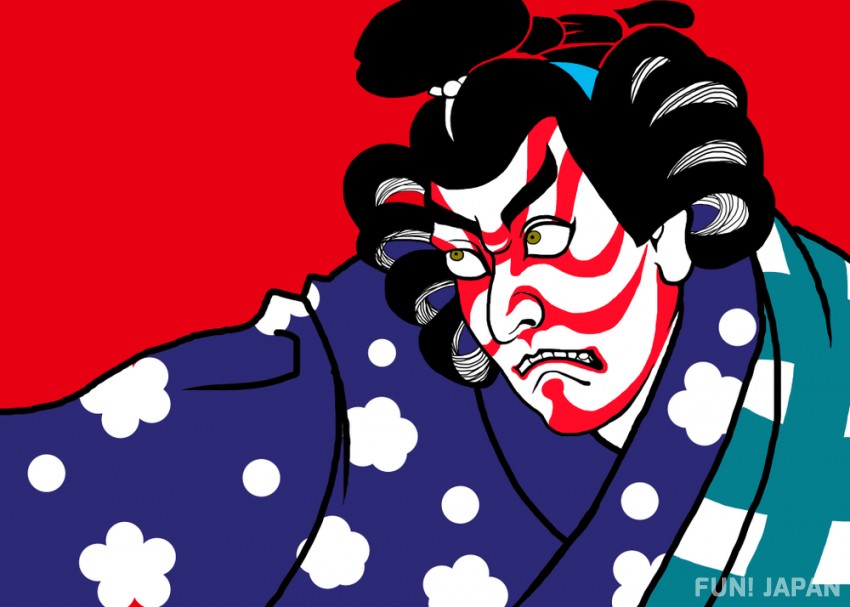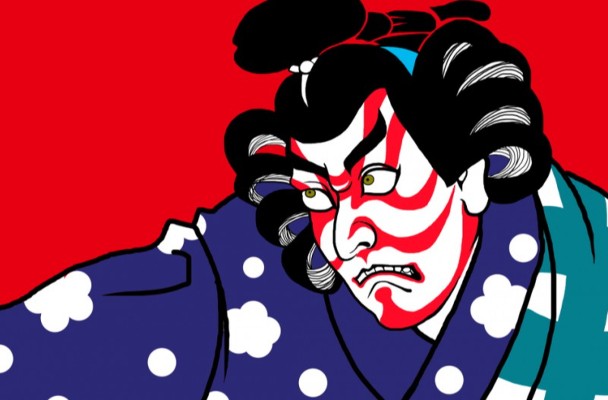
Kabuki theatre is one of Japan's many traditional art forms. It's one where you're able to tell the role of the character simply based on the way they look and speak. There are many roles that appear in kabuki theatres such as common folk, nobles, samurai, heroes, villains, priests, harlots, and more. Let's take a look at some of the defining factors of these unique roles.
Samurai (Warrior)
Kabuki roles can be split into 4 main roles, "Tachiyaku", "Onnagata", "Koyaku", and roles that are for characters that aren't human. Tachiyaku refers to all male roles that oppose the onnagata, often being used in a narrow sense to refer to the generally good people versus the villain in the story. There are also a few more specific genres within the tachiyaku role being "Jitsugoto", "wagoto", and "aragoto".
Let's take a deeper look into jitsugoto and aragoto and their characteristics.
Jitsugoto typically sees wise and mature characters. Some of the more well-known performances of this type are Kanadehon Chushin Gura's Ohboshi Yuranosuke and Sanemori Monogatari's Saitou Bettou Sanemori.
Kanadehon Chushin Gura is a story about the Forty-seven Ronin raid that took place during the Edo and Genroku period of Japan, except the period of time within the play has been changed to the Nanbokuchō period (1336-1392), with the story itself focussing on the devotion and vengeance of the warriors. Ohboshi Yuranosuke's role and model for the story is the Akō Domain chief, Ōishi Yoshio.
The clothes worn by Ohboshi Yuranosuke are known as "kurohabutae hangitsuke kuroryuumon daishouarare kamishimo". This is the formal wear used by warriors in Japan. You can see the family crest migi futatsu domoe from the Ōishi on the clothing allowing you to quickly and easily distinguish the character from the rest.
Furthermore, to help ensure no confusion is had when distinguishing the less recognizable samurai in the show, the makeup is less prominent, and the oishiroi (face powder) is mixed with the tonoko (powder made from dried clay) to create a more earthy color, that is then used alongside ink black to ensure the character stands out. You will also find that a deep blue is used for the actor's chin and eyes, there's even a time when this depicts a shaven face. All of this allows the actor to move with more constraint than the rest of the cast.
As for aragoto performances, the main character will have a large amount of shading on their face as well as wear extravagant clothing, and emphasizing both their movements and voice lines, allowing spectators to know who the main character is without issue. Let's take a look at the example of "Sugawara Denju Tenarai Kagami".
Within this story, there are 3 men who serve the main character "Kansoujyou" known as "Shiradayu". The eldest of the three is called Umeoumaru, then there's Matsuōmaru who is the Tokiyo Shinno, Kansoujyou's political rival, and the emperor's younger brother who is in Dazaifu, as well as Sakuramaru who is a toneri (servent) to the crown prince. Toneri are typically servants to nobility, and engage in defense work for the nobles and other such jobs.
Sakuramaru, who shows superhuman strength to punish the villains of the story, wears clothing with sakura blossom embroidery on his clothing, with large purple check patterns as well to ensure the spectators know he is still a child. The cotton obi used to tie this clothing is 3 meters in length.
"Bin" or sidelocks is a hairstyle that is often used within aragoto performances, with what's known as "kuruma bin" being the most common. Kuruma bin has the hair on either side of the head tied up into sections and then solidified in place at the sides of the head.
Sakuramaru's makeup has been done in a method using "sujikuma" to show vigor.
Hero & Villain
One example of a hero being depicted in aragoto kabuki theatre is Kamakura gongorou kagemasa from the story Shibaraku. The story of Shibaraku is extremely simple, it's about the rewarding of good deeds and the punishment of evil ones. It shows people without sin getting into trouble, and with a loud voice shouting "Shibaraku" Kamakura gongorou appears to help.
As Kamakura gongorou makes his way to center stage, he puts out his left foot, grasps his sword with his left hand, placing his right behind him creating a perfect "Genroku Pose". His face has red lines with large overhanging hair that contains various ornaments. His sleeves are long and clothing a reddish-brown color, with the pose to match he's almost like a modern-day hero.
If we look into the villain roles of kabuki, there's one everyone should know, "Ishikawa Goemon". While he may be called a villain, he's actually a character that loves money and will stop at nothing to obtain it, including thievery. He is said to be based on a thief from the Azuchi-Momoyama period (approx. 1558-1600), with a unique hairstyle known as "daihyaku" that makes him stand out alongside his long coat.
To oppose the red lines that heroes use, villains typically use the normally dark blue color. Sometimes indigo blue is used for this for higher ranking villains such as Kugeaku.
Commonfolk & Nobles
Kamiya Jiehi, who appears in "Shinjyu Tenno Amijima" is a paper salesman situated in Osaka. While he is a man with a wife and kids, he begins a relationship with a harlot known as Koharu, eventually leading to a double lovers' suicide. This is a role well known among Wagoto performances. You can recognize this character through his striped kimono clothing. Wagoto makeup uses a slight amount of crimson red with the oshiroi, creating a more mellow atmosphere and color.
When looking at nobles within these stories, let's look at Ichijo Okurakyo who appears in Kiichihougen Sanryakuno Maki. Okurakyo is part of the Minamoto clan and remarries to Tokiwa Gozen. To hide that he is an ally of the Minamoto Clan he acts as though he is but a silly nobleman, however, a resourceful one.
Kiichihougen Sanryakuno Maki's most well-known part is when Okurakyo stops his charade of acting foolish and shows his true colors, this is known as "Bukkaeri". This act has the actor changing clothes in an instant through a method known as "Hikinuki" with the actor showing the characters true colors.
To show nobles in kabuki, a makeup known as "Kurai hoshi" will be drawn above the actor's eyebrows, this is but another way you can tell that a character is a nobleman.
Priests & Harlots
If we're looking at characters that represent priests in kabuki, look no further than Narukami Shonin who appears in Narukamifudo Kitayama Zakura. He is a high priest who is diligent in his training, eventually becoming tempted by Kumonotaemahime, with the rope sealing the dragon eventually being cut by the same person that tempts him. The priest, becoming furious, instantly changes his clothing from white to a fiery red to show his anger.
As for the harlot role, let's look at Miuraya Agemaki from Sukeroku Yukarino Edozakura. Agemaki is top class even within Yoshiwara. She appears in a luxurious fashion with over 20 hairpins and in a women's bridal robe. Harlot makeup is typically white with hints of pink. Their eyeliner is typically done in crimson red, with a darker red for lipstick, and darker lines around the edges.

Comments